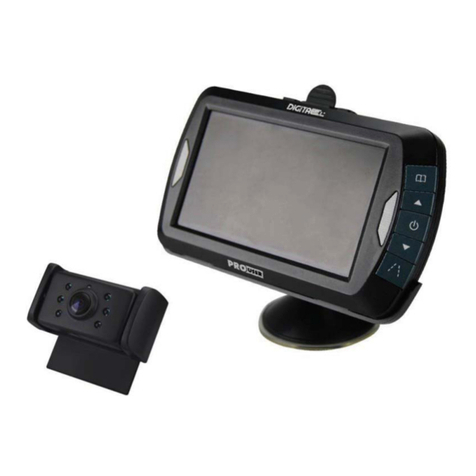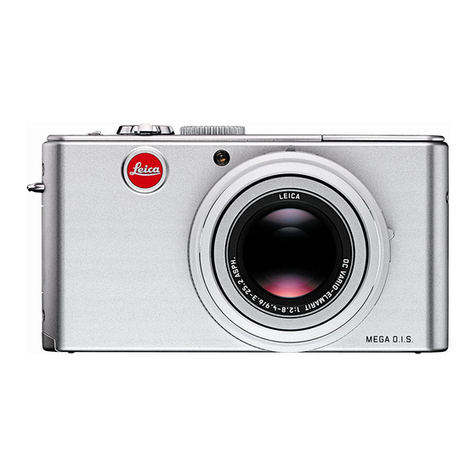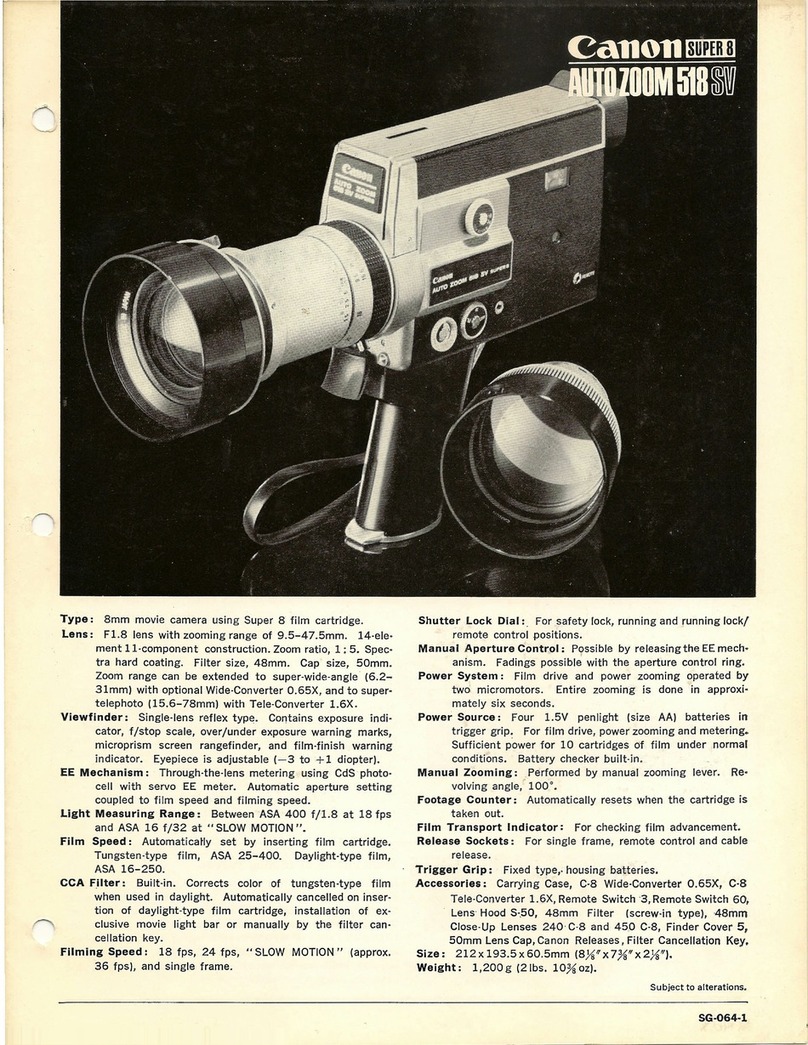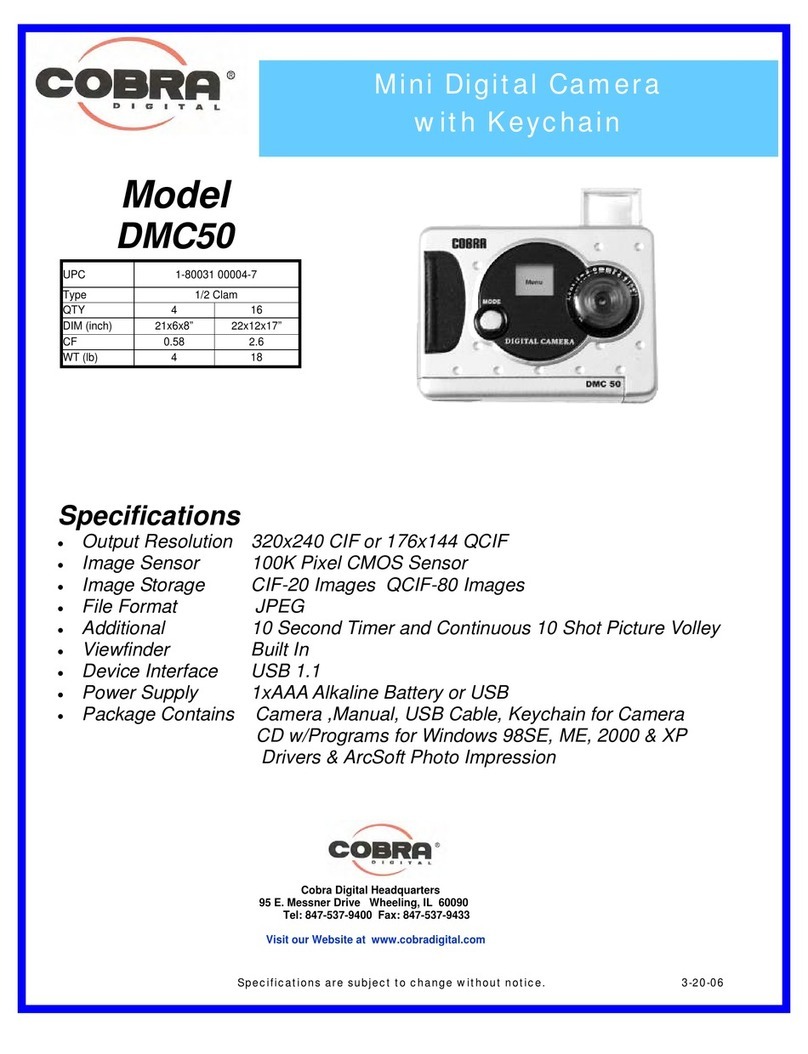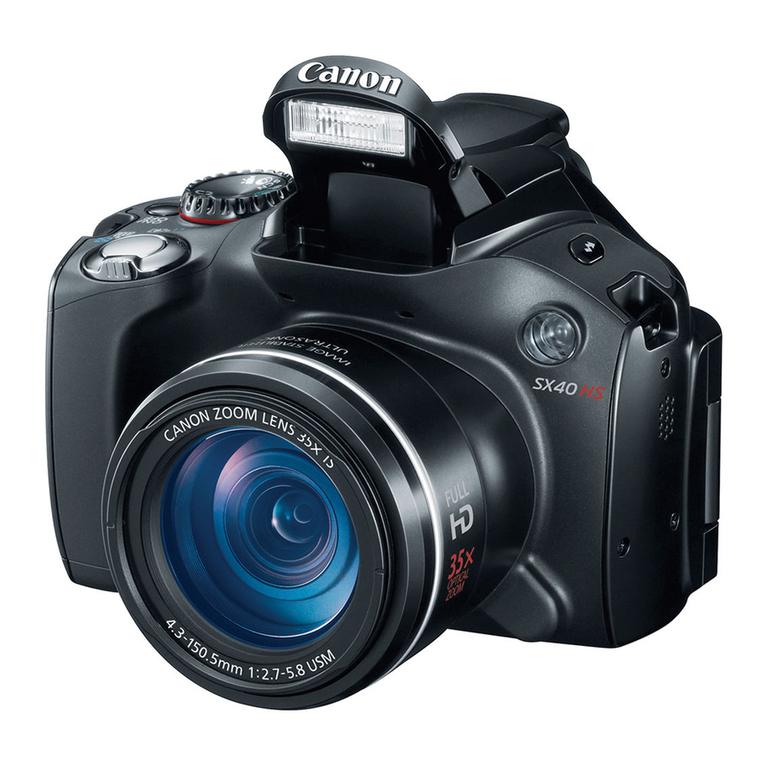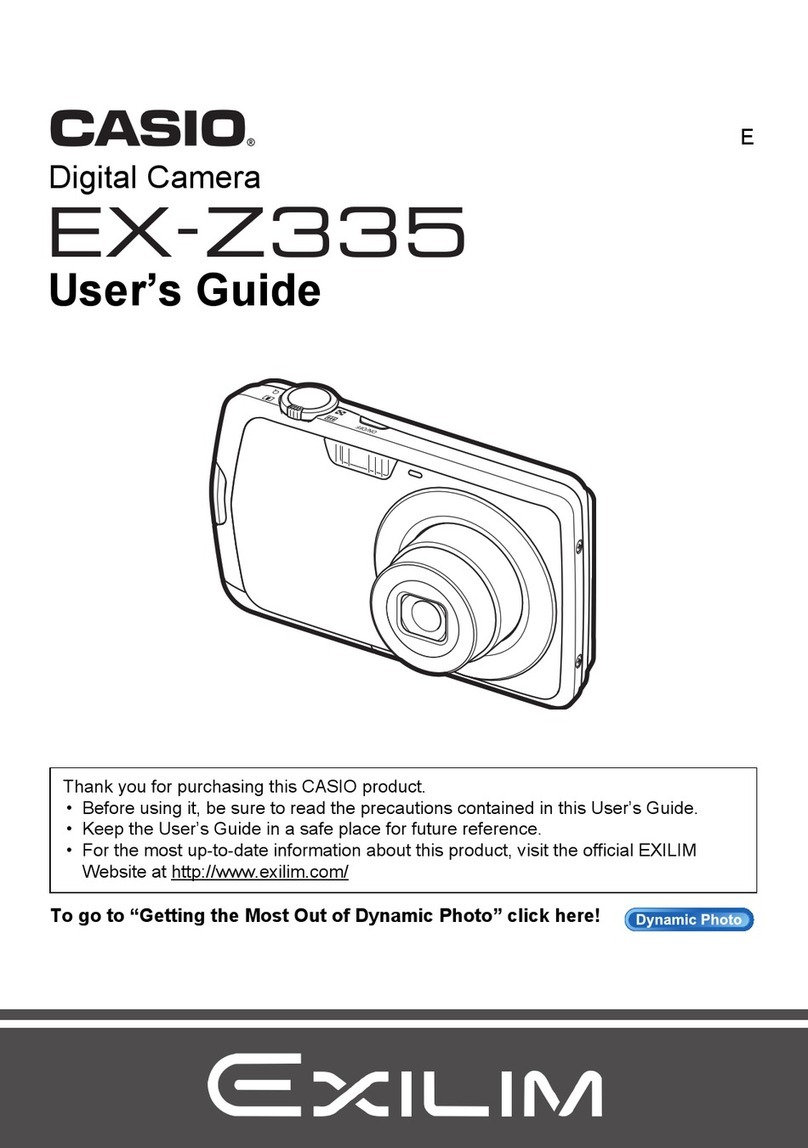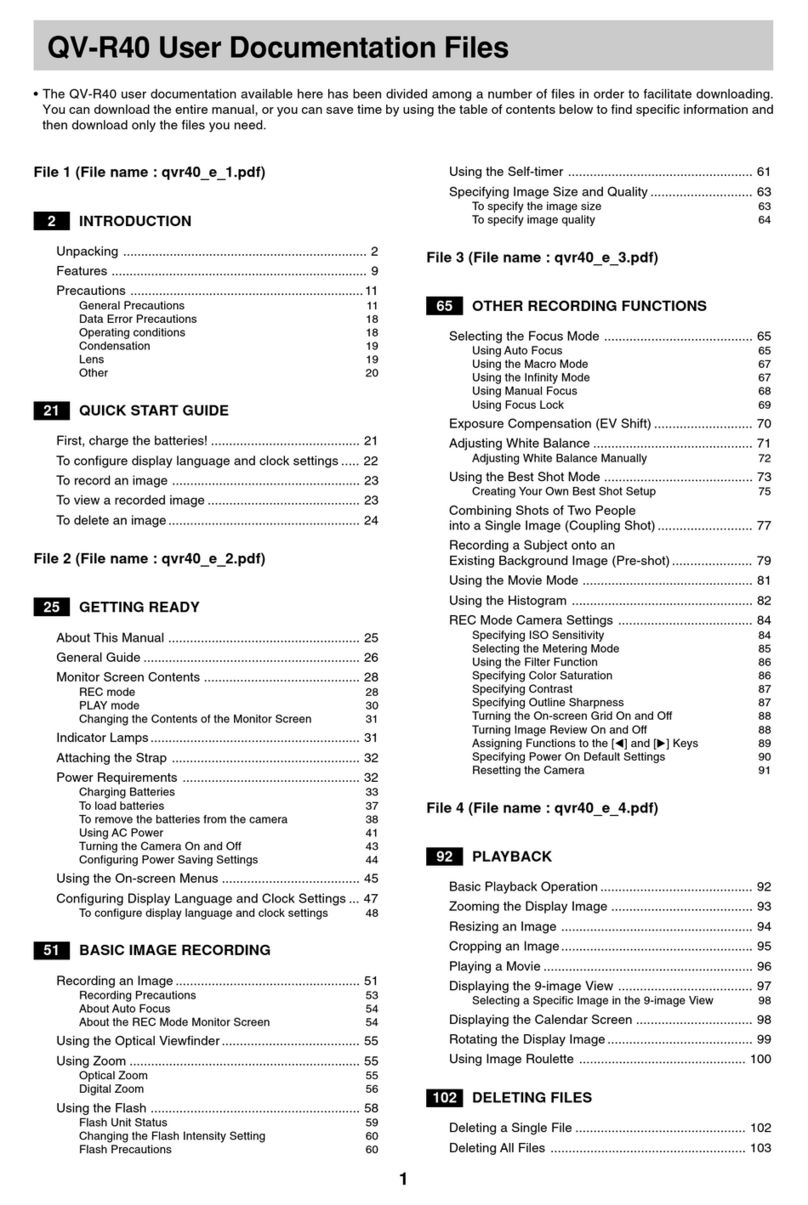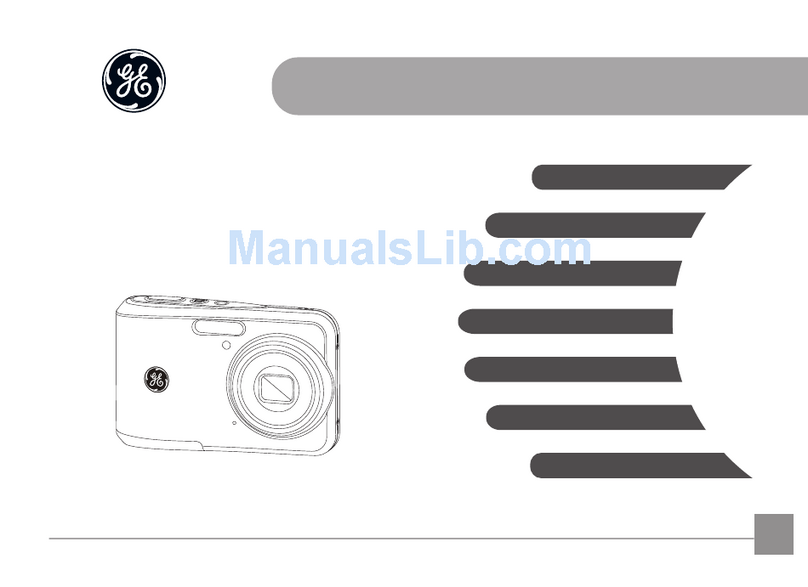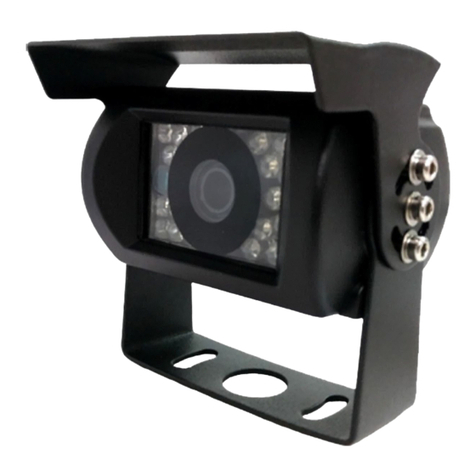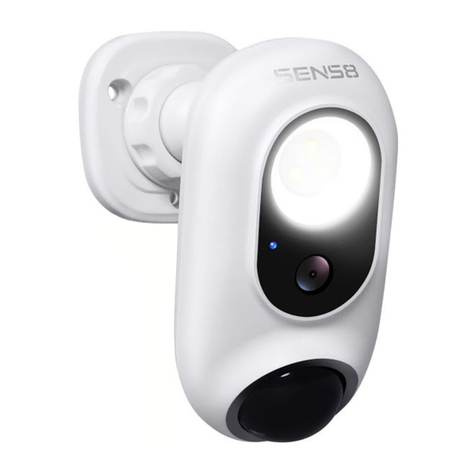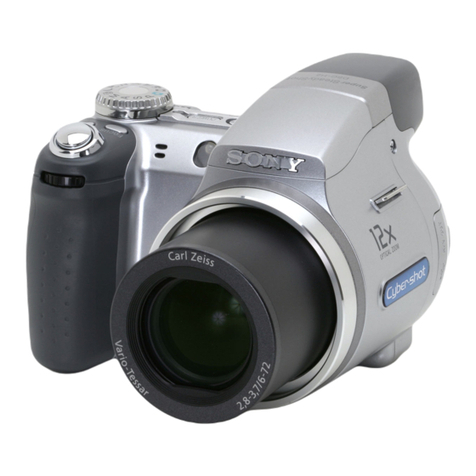pro user RVC3110 User manual

1
WIRELESS BACK-UP CAMERA SYSTEM
KABELLOSES RÜCKFAHR-KAMERA-SYSTEM
SYSTÈME DE CAMERA DE RECUL SANS FIL
DRAADLOOS CAMERASYSTEEM
with 2,4 i ch mo itor
mit 2,4” Mo itor
avec écra 2,4 pouces
met 2,4 i ch mo itor
RVC3110

2
INTRODUCTION
The Pro-User RVC3110 is member of the family of advanced car back-up systems
manufactured by Pro User nternational Ltd.
The Pro-User Wireless Back-up Camera and Monitor, when used as described, will
improve your ability to see behind your car, camper, trailer, or mini-van. We have taken
numerous measures in quality control to ensure that your product arrives in top condition,
and will perform to your satisfaction.
Please carefully read a d follow the followi g safety a d operati g i structio s.
IMPORTANT SAFETY INSTRUCTIONS
Before You I stall
f you are not confident working with 12 volt DC vehicle wiring, removing and reinstalling
interior panels, carpeting, dashboards or other components of your vehicle, contact the
vehicle’s manufacturer, or consider having the camera system professionally installed.
I terfere ce
This device, as well as all other wireless devices, may be subject to interference.
nterference may be caused by cell phones, Bluetooth headsets, Wi-F routers, power
lines and other various electrical equipment, etc.
Repair
The camera system should not be opened. Any attempt at modification or repair by the
user will entail the loss of your guarantee.
PARTS
1. Monitor and mounting Arm 2. Camera with mounting plate
3. Transmitter Box 4. Mounting Accessories 5. Monitor Power Cable
6. Transmitter Box Power Cable

3
INSTALLATION
These i structio s do ot apply to all vehicles. They are o ly mea t as a ge eral
guide due to the umber of differe t makes & models. For vehicle specific
questio s co tact your vehicle’s ma ufacturer.
Camera i stallatio
There are several ways to mount the camera on the back of your car. But the most
convenient is to mount it near the license plate of the car. Supplied is one mounting plate
that can be fixed behind the license plate, and the mounting plate have been installed in
the camera.
The camera is tiltable, camera angle can be adjusted manually on vertical direction.
Make
sure that its field of view and detection are not obstructed.
At some type of cars it is not possible to mount the camera near the license plate. You
may have to find another spot at the back of your car to mount the camera.
1. Remove the rear license plate, and then loosen the license plate bolts/screws.
2. Position the supplied mounting plates (with camera together) behind the license plate
bracket. Secure both license plate bracket and mounting plates with the license plate
bracket bolts/screws.

4
3. Mount the license plate on the license plate bracket.
4. Choose a routing path for the camera’s power cable through the vehicle’s body to the
reverse light circuit. f in doubt, seek professional installation assistance.
5. Some vehicles may have a hole available to pass the wire through, such as where the
license plate light is mounted, or you can drill a hole close to where the power cable
is attached to the camera. Once you have chosen where the cable will enter the
vehicle’s body, remove the camera. If you are able to use an existing opening, skip
the next two steps.
6. Before you drill a hole you MUST CHECK and see WHAT S BEH ND WHERE YOU ARE
DR LL NG. f there are any vehicle components, such as electrical parts or fuel
system components behind where you are drilling, you must take whatever
precaution is necessary not to damage them. Remove the license plate and camera
before drilling.
7. After you have drilled the hole, insert the supplied grommet, then pass the camera
cables through the grommet into the vehicle. You must use the grommet to prevent
the metal edge of the hole from cutting the camera cable.
8. Mount the transmitter box inside the trunk. Connect the camera’s power cable and
the transmitter box power cable to the transmitter box.
9. Next you’ll need to find the vehicle’s reverse lights. Turn the vehicle’s ignition key to
the accessory position, engage the parking brake and put the car in reverse. Look at
the vehicle’s tail lights to see where the reverse lights are located, they are the white
lights. To locate the reverse light’s 12V+ wire it will be necessary to gain access to
the rear of the vehicle’s tail light. For help locating the vehicle’s reverse light circuit
contact your vehicle’s manufacturer for vehicle specific wiring diagrams.
10. Once you have located the reverse light circuit you will have to route the transmitter
box power cable to that location. You must securely fasten the power cable to prevent
it from being caught on any vehicle component such as the trunk hinge. Never route
the cable on the outside of the vehicle!

5
11. The reverse light sockets on
most vehicles have two wires
connected to them. Usually the
negative wire is black and the
positive wire is a colored wire. f
you are uncertain about the
wiring, you can use a 12 volt
multimeter available at most
auto parts stores to determine
which is the positive wire. Follow
the manufacturer’s instructions
for the safe use of the
multimeter.
12. After determining which wire is
the positive and which is the negative, turn off the ignition key, then remove the
battery’s negative cable.
13. Splice the red wire using the supplied in-line wire connectors to the reverse light’s
positive (+) wire. Use a set of slip joint pliers to squeeze the TAP and insure good
connection.
14. Next splice the black wire of the transmitter box power cable to the reverse light’s
negative (-) wire or ground.
15. Replace the reverse light bulb, and then re-install the light socket. Secure all the
wires with cable ties or electrical tape.
16. Re-attach the negative battery cable to the battery.
Mo itor I stallatio
When choosing a location to mount the monitor, make sure the
monitor is in an area that will not obstruct your vision while driving.
1. Before mounting the monitor, clean the mounting surface well.
2. Position the suction mount to the smooth surface which suits
your requirement.
3. Press the suction cap against the smooth surface and press the
lock down to attach and fix the mount to the surface.
4. Snap in the monitor to the suction mount.
5. Adjust the mounting arms to suit your view angle to the monitor and tighten the
screws on the mount to fix the position.

6
6. Route the power cable to the vehicle’s cigarette lighter socket/12V power outlet. The
cable must not interfere with the safe operation of the vehicle.
7. nsert the small 12 Volt DC plug of the power cable into the right side of the monitor.
8. Plug the 12 Volt cigarette lighter plug into the vehicle’s cigarette lighter socket.
To maximize the effectiveness of the suction mount, it is recommended that the
application be performed under the following conditions:
•Surface temperature should be between 21 and 38 degrees Celsius.
•Application below 10 degrees should be avoided.
•Application should not occur in direct sunlight.
Mounting should be protected from exposure to direct sunlight for a period of 24 hours.
NOTE: UNDER EXTREME BR GHT L GHT COND T ONS, THE SCREEN MAGE MAY TAKE A
FEW SECONDS TO STABL ZE. PLEASE WA T UNT L THE MAGE HAS STABL ZED BEFORE
BACK NG UP.
System testi g
1. Reattach the vehicle’s negative battery cable.
2. Turn the ignition key to the accessory position, do not start the vehicle.
3. Engage the parking brake, and then put the shifter in the reverse position.
4. Look at the monitor, if the image does not match your rear view mirror press the
mage Orientation button on the monitor to correct the image.
5. After testing the unit and you are satisfied with the route you have chosen for the
cabling, you must permanently install it.
6. Route all wires behind interior panels or under carpeting so they are hidden. Use
supplied cable ties to neatly gather any excess wire.

7
OPERATION
The monitor will automatically turn on when the vehicle is in reverse gear.
There are 4 control buttons available for users to have their controls:
Power butto
Press the POWER button to supply power to the monitor. When the monitor image is on,
the blue LED will be lit. f there is power to the monitor, but the monitor image is OFF,
the blue LED will blink on and off. When the monitor power is off, no picture can appear
on the screen and the blue LED will be off.
Bright ess butto
There are 10 levels of brightness. To adjust the brightness, press the Brightness Control
button. Pressing the button to increase the brightness at the highest level will return to
the lowest level.
Co trast butto
There are 10 levels of contrast. To adjust the contrast, press the Contrast Control button.
Pressing the button to increase the contrast at the highest level will return to the lowest
level.
Image Orie tatio butto s
Press these buttons to reverse the angle of the camera.
mage orientation buttons
Brightness button
Power button
Contrast button

8
TECHNICAL SPECIFICATIONS
Camera
Operating Voltage 12V DC
Current consumption <150mA
mage sensor CMOS
No. of pixel 640x480
Resolution >330
Optical lens 2,4mm / F2,1
Wireless tra smitter
Transmission frequency 2414MHz
RF transmission distance (open space) >60M
LCD mo itor
Operation Voltage 12V DC
Standby Current <20mA
Operation Current <200mA
LCD display screen size 2,4inch
No. of pixel 480x240
Operation temperature -10 to +45 degree Celsius
ENVIRONMENTAL PROTECTION
Waste electrical products should not be disposed of with household waste.
Please recycle where facilities exist. Check with your local authority or
retailer for recycling advice.
WARRANTY
Pro-User warrants this product for a period of 2 years from the date of purchase to the
original purchaser. Warranty is not transferable. Warranty covers defect against
workmanship and materials only. To obtain warranty service, please return the unit to
the place of purchase or authorized Pro-User dealer together with your proof of purchase.
The warranty is void if the product has been damaged or not used as described in this
manual. Warranty is void if a non-authorized repair has been performed. Pro-User makes
no other warranty expressed or implied. Pro-User is only responsible for repair or
replacement (at Pro-Users’ Discretion) of the defective product and is not responsible for
any consequential damage or inconvenience caused by the defect.

9
EINLEITUNG
Der Artikel Pro-User RVC3110 gehört zur Familie der zukunftsweisenden Auto-Rückfahr-
Kamera-Systeme der Firma Pro-User- nternational Ltd.
Die kabellose Pro User Rückfahr-Kamera mit Monitor ermöglicht es hnen bei
ordnungsgemäßer Bedienung, hinter hr Auto, hren Anhänger oder Mini-Van zu sehen.
Es wurden zahlreiche Maßnahmen bei der Qualitätskontrolle ergriffen, um hnen ein Top
Produkt zu hrer Zufriedenheit zu liefern.
Bitte lese Sie die Bedie u gsa leitu g sorgfältig durch u d folge Sie de
Sicherheitshi weise u d der Mo tagea leitu g.
WICHTIGE SICHERHEITSHINWEISE
Vor der Mo tage
Falls Sie sich nicht sicher fühlen, dieses System an die 12V Stromversorgung hres
Fahrzeuges selbstständig zu montieren (bohren von Löchern, abnehmen von
Verkleidungen etc.) nehmen Sie Kontakt zu hrem Autohaus oder zur Kfz-Werkstatt hres
Vertrauens auf. Dort können Sie eine professionelle Montage des Systems in Auftrag
geben.
Störu g
Dieses Kamera-System kann, genau wie andere kabellosen Systeme, bestimmten
Störungen unterliegen. Störungen können verursacht werden durch Handys, Bluetooth,
Headsets, Navigationssysteme und anderen elektrischen Geräten.
Reparatur
Dieses Kamera-System darf nicht geöffnet werden! Bei jeglichem Versuch einer
Reparatur erlischt die Garantie.
ZUBEHÖR
1. Monitor mit Befestigungsarm 2. Kamera mit Befestigungsplatte
3. Sender 4. nstallations- Material 5. 12V Kabel für Monitor
6. Netzkabel für Sender

10
MONTAGE
Diese Bedie u gsa leitu g ist icht für alle Fahrzeuge a zuwe de . Sie ist ei
ge ereller Leitfade für die meiste Fahrzeuge. Bei fahrzeugspezifische Frage
we de Sie sich bitte a Ihre Fahrzeughersteller.
Mo tage der Kamera
Es gibt verschiedene Möglichkeiten, die Kamera an der Rückseite hres Fahrzeuges zu
befestigen. die Gebräuchlichste ist, die Kamera nahe dem Nummernschild zu befestigen.
Sie können die mitgelieferte Montageplatte hinter dem Nummernschild befestigen. Auf
diese Montageplatte können Sie nun die Kamera montieren.
Die Kamera ist vertikal schwenkbar, bitte stellen Sie diese nach den Gegebenheiten ein.
Bei manchen Fahrzeugen ist es leider nicht möglich, die Kamera nahe dem
Nummernschild zu befestigen. Suchen Sie sich eine andere Stelle am Heck hres Autos
und befestigen Sie die Kamera mit den mitgelieferten Schrauben und Muttern.
1. Nehmen Sie das Nummerschild aus der Halterung und lösen Sie dannach die
Schrauben des Nummernschildhalter und nehmen dieses ab..
2. Positionieren Sie die Befestigungsplatte mit der Kamera hinter dem
Nummernschildhalter und befestigen Sie die Befestigungsplatte und den
Nummernschildhalter am Fahrzeug.

11
3. Befestigen Sie nun hr Nummernschild wieder auf dem Nummernschildhalter.
4. Wählen Sie jetzt eine Stelle, wo Sie das Elektrokabel der Kamera durch die Karosserie
hres Autos zum Stromkabel des Rückfahrlichtes ziehen können.
5. Einige Autos haben in der Nähe des Kennzeichens eine Bohrung, wo Sie das Kabel
durchziehen können. Falls das nicht der Fall ist, müssen Sie in der Nähe des
Kennzeichens, dicht an der Stelle, wo sich das Kabel der Kamera befindet, selber ein
Loch bohren. Wenn Sie den Platz für das Bohrloch festgelegt haben können Sie die
Kamera und das Kennzeichen wieder demontieren. Wenn Sie eine vorhandene
Öffnung benutzen, können Sie die zwei folgenden S hritte überspringen.
6. Bevor Sie bohren, demontieren Sie die Kamera und das Nummernschild. PRÜFEN S E,
BEVOR S E BOHREN, WAS S CH AUF DER RÜCKSE TE DER STELLE BEF NDET, WO
S E BOHREN WOLLEN! Sorgen Sie z.B. dafür, dass sich dort keine Elektrokabel,
Flüssigkeitstanks oder Leitungen befinden. Beachten Sie alle Vorsichtsmaßnahmen!
7. Nachdem Sie gebohrt haben, befestigen Sie den mitgelieferten Kantenschutz in der
Bohrung, um das Kabel vor den scharfen Rändern des Bohrloches zu schützen. Dann
ziehen Sie das Kabel der Kamera ins Fahrzeuginnere.
8. Befestigen Sie den Sender im Kofferraum. Verbinden Sie das Kabel der Kamera und
das Kabel des Senders mit dem Sender.
9. Schalten Sie die Zündung hres Auto an (nicht starten!), ziehen Sie die Handbremse
an und legen Sie den Rückwärtsgang ein. Dann schauen Sie am Heck hres Autos, wo
sich der Rückfahrscheinwerfer befindet. Um die Kabel vom Rückfahrscheinwerfer zu
finden, müssen Sie die Rückseite der Heckbeleuchtung öffnen und die
entsprechenden Kabel orten. Ggf. suchen Sie hierzu hr Autohaus oder die Kfz-
Werkstatt hres Vertrauens auf.
10. Wenn Sie die entsprechenden Kabel gefunden haben, legen Sie das Kabel des
Senders an den Verbindungspunkt. Sorgen Sie bitte dafür, das die Befestigung des
Kabels sicher und fest ist, damit es beim Öffnen und Schließen der Heckklappe nicht
beschädigt werden kann. Verlegen Sie das Kabel iemals außerhalb des Autos!

12
11. An der Kontaktdose des
Rückfahrscheinwerfers sind zwei
Drähte befestigt. Meistens ist der
negative Draht schwarz und der
positive farbig. Wenn Sie unsicher
sind, können Sie mit einem 12 V
Multimeter (im Fachhandel
erhältlich) prüfen, welcher Draht
positiv bzw. negativ ist. Folgen Sie
der Bedienungsanleitung des
Multimeters für den sicheren
Gebrauch.
12. Wenn Sie festgestellt haben,
welcher Draht positiv bzw. negativ
ist, schalten Sie die Zündung aus und entfernen Sie das negative Kabel hrer
Autobatterie. So ist sichergestellt, das kein Strom auf den Drähten ist.
13. Verbinden Sie den roten Draht vom Kabel des Senders mit dem positive Draht des
Rückfahrscheinwerfers. Benutzen Sie dazu die beiliegenden Kabelklemmen. Drücken
Sie die Klemmen fest mit einer Zange zusammen und clipsen Sie die rote
Plastikabdeckung über diese Kontaktstellen.
14. Verbinden Sie nun den schwarzen Draht des Sender-Kabels mit dem negative Draht
des Rückfahrscheinwerfers. (Benutzen Sie auch hier die Kabelklemmen)
15. Verschließen Sie die Heckleuchte wieder (achten Sie darauf, dass die Glühlampe
eingesetzt ist). Benutzen Sie Kabelbinder und spezielle Tapes (für
Kabelverbindungen), damit alle Drähte und Kabel sicher und fest verlegt sind!
16. Schließen Sie das negative Kabel hrer Autobatterie wieder an.
Mo tage des Mo itors
We Sie de passe de Platz zur Befestigu g des Mo itors
gefu de habe , vergewisser Sie sich, das Ih e icht die
Sicht versperrt wird währe d der Fahrt.
1. Reinigen Sie die Stelle gründlich vor der Befestigung
2. Positionieren Sie den Sauger auf der von hnen gewählten Fläche
3. Pressen Sie den Sauger fest auf die gereinigte Oberfläche und
legen Sie den Hebel um damit der Sauger sicher und fest sitzt.
4. Schieben Sie den Monitor in die am Sauger befindliche Halterung.
5. Drehen Sie den Arm der Halterung und richten Sie den Bildschirm in die gewünschte
Position aus. Drehen Sie nun die Schrauben an.

13
6. Legen Sie das Netzkabel zum Zigarettenanzünder. Verlegen Sie das Kabel so, das es
zu keinen Einschränkungen oder Behinderungen während der Fahrt kommen kann.
7. Stecken Sie den kleinen 12V Stecker von dem Netzkabel in die Öffnung auf der
rechten Seite vom Monitor.
8. Den anderen Stecker des Kabels stecken Sie in den Zigarettenanzünder.
Um den festen Halt des Saugers zu gewährleisten wird der Gebrauch nur unter
Einhaltung folgender Voraussetzungen empfohlen:
•Die Temperatur der Oberfläche sollte zwischen 21 und 38 Grad Celsius liegen.
•Der Gebrauch unter 10 Grad Celsius sollte vermieden werden.
•Der Gebrauch bei direkter Sonneneinstrahlung sollte vermieden werden.
Die Befestigung sollte vor direkter Sonneneinstrahlung geschützt werden.
ACHTUNG: BEI EXTREM HELLEN LICHTVERHÄLTNISSEN BENÖTIGT DER
MONITOR EINIGE SEKUNDEN UM SICH DIESEN LICHTVERHÄLTNISSEN
ANZUPASSEN. WARTEN SIE BITTE MIT DEM RÜCKWÄRTS FAHREN BIS SICH DAS
BILD STABILISIERT HAT.
System Test
1. Prüfen Sie, ob Sie das negative Kabel der Autobatterie wieder befestigt haben.
2. Schalten Sie die Zündung hres Autos an (bitte nicht starten)
3. Ziehen Sie die Handbremse an und legen Sie den Rückwärtsgang ein.
4. Schauen Sie auf den Monitor. Wenn dieses Bild nicht identisch ist mit dem Bild, was
Sie im Rückspiegel sehen, drücken Sie den Bild-Orientierungs ( mage Orientation)
Knopf am Monitor um das Bild zu korrigieren.
5. Nachdem Sie den Test zur Zufriedenheit beendet haben verlegen Sie alle noch frei
liegenden Kabel.
6. Verlegen Sie nun alle Kabel hinter den Fahrzeugverkleidungen oder unter den
Fahrzeugteppichen, so daß sie nicht mehr sichtbar sind. Gebrauchen Sie die
beiliegenden Kabelbinder um die Kabel ordentlich zusammen zu binden.

14
BEDIENUNG
Der Monitor schaltet sich automatisch an, wenn der Rückwärtsgang eingelegt wird. Des
Weiteren sind 4 Kontrollknöpfe am Monitor vorhanden.
Power Schalter
Drücken Sie den Power Schalter um den Monitor mit Strom zu versorgen. Wenn das Bild
da ist, leuchtet die blaue LED auf. Wenn der Monitor Strom hat, aber das Bild ausgestellt
ist, blinkt die blaue LED.
Helligkeit
Es gibt 10 verschiedene Helligkeitsstufen. Drücken Sie auf den Knopf um die Helligkeit
anzupassen. Wenn Sie den Knopf gedrückt halten, dann geht die Helligkeit zuerst zur
höchsten Stufe und anschließend Schritt für Schritt zur untersten Stufe weiter.
Ko trast
Es gibt 10 verschiedene Kontrasteinstellungen. Drücken Sie auf den Knopf um den
Kontrast anzupassen. Wenn Sie den Knopf gedrückt halten, dann wird der Kontrast erst
höher, bis das höchste Niveau erreicht ist. Anschließend geht der Kontrast runter bis zum
tiefsten Niveau.
Ausrichtu g
Um die Ausrichtung des Monitor-Bildes zu ändern drücken Sie diese Tasten.
Ausrichtun
g
Helligkeit
Power Schalter
Kontrast

15
TECHNISCHE SPEZIFIKATION
Kamera
Betriebsspannung 12V DC
Stromverbrauch <150mA
Bildaufnahme CMOS
Pixel 640x480
Bildauflösung >330
Linse 2,4mm / F2,1
Kabelloser Tra smitter
Übertragungsfrequenz 2414MHz
Übertragungsdistanz (frei) >60M
LCD Mo itor
Betriebsspannung 12V DC
Stromverbrauch min. <20mA
Stromverbrauch max. <200mA
Sichtbarer LCD Monitor 2,4inch
Pixel Bildschirm 480x240
Temperatur bei Gebrauch -10 to +45 Grad Celsius
UMWELTSCHUTZ
Unbrauchbare oder defekte elektronische Produkte dürfen nicht mit dem
Hausmüll entsorgt worden. Bitte entsorgen Sie diese Geräte an den dafür
vorgesehenen Entsorgungsstellen oder fragen Sie hren Fachhändler.
GARANTIE
Pro User gewährt eine Garantie von 2 Jahren ab Kaufdatum. Die Garantie ist nicht
übertragbar. Garantie wird gewährt auf Verarbeitungsmängel und Materialschäden. n
Garantiefällen senden Sie bitte das Gerät mit dem Kaufbeleg an hren Händler oder an
einen autorisierten Pro User Vertreter. Die Garantie erlischt, wenn das Gerät beschädigt
wurde, wenn Bedienungsfehler vorliegen oder bei unfachmännischer Reparatur durch
nicht autorisierte Personen. Bei anerkannter Garantie wird Pro User das Gerät reparieren
oder Ersatz leisten. Pro User ist nicht verantwortlich zu machen für Folgeschäden oder
sonstige Unannehmlichkeiten.

16
INTRODUCTION
Le Pro-User RVC3110 fait partie de la gamme de cameras de recules sans fils de
dernières génération fabriqués par Pro User nternational Ltd.
Félicitations! Le système Pro-User améliorera considérablement votre vue vers l'arrière
de votre voiture, camping-car, caravane ou remorque, si vous l'utilisez comme décrit ci-
dessous. Nous avons testé sérieusement ce système pour être sûr que vous pourrez vous
en servir sans problèmes et que vous serez entièrement satisfait de son fonctionnement.
S’il vous plait, veuillez lire atte tiveme t cette otice et suivre les i structio .
IMPORTANT - CONSIGNES DE SECURITE
Ava t l’i stallatio
Si vous ne vous sentez pas capable d’intervenir sur le circuit électrique 12 volt DC d'une
voiture, de démonter et remonter les panneaux intérieurs, la moquette, le tableau de
bord ou d'autres pièces de votre voiture, on vous conseille de prendre contact avec votre
concessionnaire, votre garage ou centre auto pour faire installer ce système de façon
professionnelle par une personne qualifié.
I terfére ce
Comme tous les systèmes sans fil, le Pro-User pourra être troublé dans son
fonctionnement par des portables, des casques bluetooth, des systèmes GPS, des câbles
électrique, ou par d'autres appareils électriques.
Réparatio
La camera et le moniteur ne doivent jamais êtres ouvert. Autrement l’utilisateur pert la
garantie.
CONTENU
1. Moniteur et bras de fixation 2. Camera avec plaque de fixatoion
3. Boîtier transmetteur 4. Accessoires de fixation 5. Câble d’alimentation
6. Câble d’alimentation transmetteur

17
INSTALLATION
C’est i structio s d’i stallatio e s’applique t pas à tous les véhicules mais à
la majorité. Sur certai s véhicules il ’est pas possible de fixer la caméra sur la
plaque d’immatriculatio . Da s ce cas co tacter votre co cessio aire ou votre
garagiste afi de trouver u autre e droit approprié.
Camera i stallatio
l y’a différentes manières de fixer la camera de recule. La plus pratique étant à
proximité de la plaque d’immatriculation du véhicule. Nous fournissons 1 plaque de
montage qui se fixent derrière la plaque d’immatriculation. La caméra de recule peut se
fixer sur ces plaques de montages. La caméra est inclinable, l’angle de vue peut donc
être ajusté manuellement verticalement. Assurez vous que le champ de vue de la camera
est libre.
Sur certains véhicules il n’est pas possible de fixer la camera à proximité de la plaque
d’immatriculation. Alors il vous faut trouver un autre endroit à l’arrière du véhicule pour
fixer la caméra.
1. Enlevez la plaque d’immatriculation (et porte plaque) en la dévissant ou en enlevant
les rivets.
2. cez la plaque de montage (ensemble avec la caméra) derrières la plaque
d’immatriculation puis fixez les solidairement avec la plaque d’immatriculation. Par vis ou
rivets.

18
3. er la plaque d’imatriculation sur le support de plaque.
4. isissez un chemin d’accès pour le câble d’alimentation de la camera dans l’intérieure
du coffre de votre véhicule afin de le brancher sur le faisceau électrique de l’ampoule
de marche arrière. Si vous avez des doutes, consultez un professionnel. Votre
garagiste, centre auto ou concessionnaire.
5. Certains véhicules ont d’origine un trou à cet effet, qui vous permet de faire passer le
câble d’alimentation. Dans le cas contraire il vous faut percer un trou. De préférence
derrière la plaque d’immatriculation. Une fois que vous avez identifié l’endroit retirez
la camera. Si vous avez la possibilité d’utiliser un trou de passage existant alors vous
pouvez sauter le 2 points suivants.
6. Avant de PERCER un TROU, vous devez VER F ER CE QU’ L Y’A DERR ERE, à
l’intérieur de votre véhicule. Si il y’à des câbles, composant ou autre objet, alors vous
devez choisir un autre endroit pour percer le trou. Enlever la plaque et la caméra
avant de percer.
7. Après avoir percer le trou, veuillez insérer la bague de passage fournie. Elle protège
votre câble d’alimentation contre les bords tranchants.
8. Maintenant fixez le boîtier transmetteur dans votre coffre. Raccordez le câble
d’alimentation à votre caméra puis au boîtier de transmission.
9. En suite vous devez identifier l’ampoule de marche arrière (généralement le feu
blanc). Tournez la clef de contact de votre véhicule, serrez le frein à main puis
enclencher la marche arrière. Regardez à l’arrière de votre véhicule ou demander à
une autre personne de regardez quelle ampoule s’allume. Trouvez le câble qui
alimente l’ampoule de marche arrière. Pour se faire vous devez retournez à l’arrière
de votre véhicule. Si vous n’y parvenez pas alors consultez un professionnel, votre
garagiste ou concessionnaire.
10. Une fois le circuit électrique le l’ampoule de marche arrière identifié, vous devez
passer le câble d’alimentation du boîtier transmetteur vers le câble électrique de
l’ampoule. Fixez le de manière très sûr. Le câble ne doit pas pouvoir être arraché par
des objets transportés dans le coffre ultérieurement. Ne jamais faire passer le câble
à l’extérieur du véhicule!
11. La plus part des ampoules de marche
arrière sont alimenté par 2 fils
électriques. En général le noir est le
négatif et le rouge le positif. Dans le
doute contrôlez avec un voltmètre 12V
(disponible dans la majorité des
magasins de bricolage) ou allez consulter
un professionnel. Suivez les instructions
de la notice du voltmètre.

19
12. s avoir déterminé les polarités des fils électriques veuillez retirer la clef de contacte
puis déconnectez la cosse (-) négative de votre batterie de démarrage (la batterie se
situe souvent dans le compartiment moteur du véhicule), ceci afin d’être sûr qu’il n’y
ai plus de courant dans les circuits électrique. Pour trouver la batterie veuillez
consulter la notice de votre véhicule.
13. Fixez le fil rouge du câble de l’émetteur à l’aide du connecteur rouge dans le câble
positif (+) des feux de recule. Prenez une pince pour faire entrer la languette
métallique et pliez/accrochez ensuite le couvercle rouge en plastique.
14. Puis répétez l’opération (14) avec le câble négatif (-) (souvent noir).
15. Replacez l’ampoule de marque arrière et le cache puis sécuriser les câbles de sorte
qu’il de puisse pas être accrochés par un objet transporté dans le coffre. Pour
sécuriser les câbles, veuillez utiliser des serre-fils ou du ruban adhésif pour
installations électriques.
16. Reconnecté la cosse négative à votre batterie.
I stallatio du mo iteur
Choisiser un endroit qui ne puisse pas gêner la visibilité du
conducteur ou d’une manière générale gêner la conduite.
1. Avant de fixer la ventouse, veuillez bien nettoyer l’endroit ou
vous voulez la fixer.
2. Positionner la ventouse sur une surface parfaitement plane, lisse
et propre.
3. Appuyer la ventouse sur la surface et faite basculer le loquet.
4. Enficher le moniteur sur la fixation.
5. Ajuster l’orientation du moniteur puis serer la vis.

20
6. Passer la câble d’alimentation entre le moniteur et votre prise allume cigare de sorte
qu’il ne puisse en aucun cas gêner le conducteur. Même si il devait tomber.
7. nsérer le petit connecteur dans le côté droit du moniteur, c’est le câble
d’alimentation 12V.
8. Brancher la prise d’alimentation dans la prise allume cigare de votre véhicule.
Pour optimiser la fixation du moniteur sur le tableau de bord il est recommandé:
•De l’installer lors de températures ambiantes de 21 à 38 C°.
•De ne pas le coller lors de températures sous 10 C°.
•Ne pas exposer la fixation directement au soleil.
•De bien dégraisser l’endroit de fixation.
Protéger l’installation des rayons du soleil pendant 24 heures.
REMARQUE: lors d’une lumière ambiante très Claire, le moniteur nécessite un certain
temps d’adaptation.
Pour tester le système
1. Assurez vous que la cosse négative est branchée sur la batterie du véhicule.
2. Mettez le contact en tournant la clef, ne démarrez pas..
3. Serrez le frein à main puis engagez la marche arrière.
4. Regardez le moniteur, si l’image ne correspond pas à celle que vous voyez dans le
rétroviseur, veuillez appuyer sur la touché d’orientation de l’image.
5. Une fois le test effectué et si vous êtes satisfait du résultat, alors fixer définitivement
les câbles d’alimentation dans votre coffre.
6. Placez les câbles derrière les caches et moquettes de votre véhicule. Utilisez les
serres fils fournis pour fixer le surplus de câbles.
Table of contents
Languages:
Other pro user Digital Camera manuals
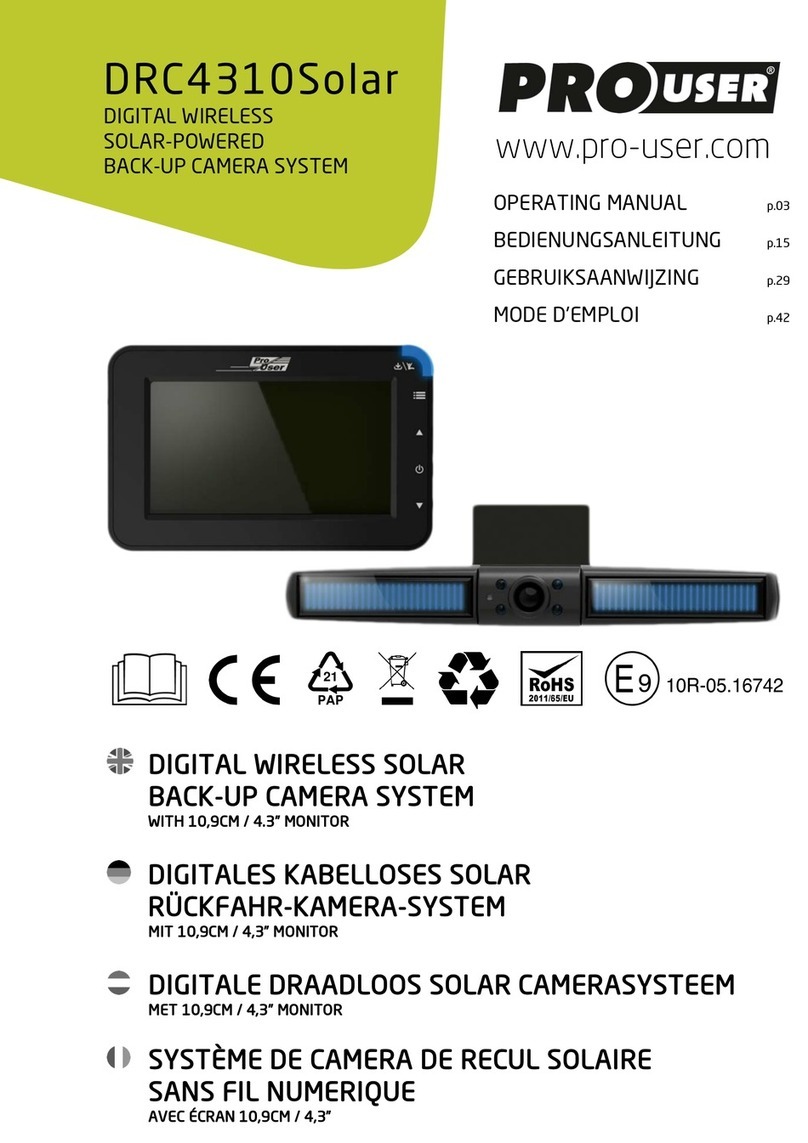
pro user
pro user DRC4310Solar User manual
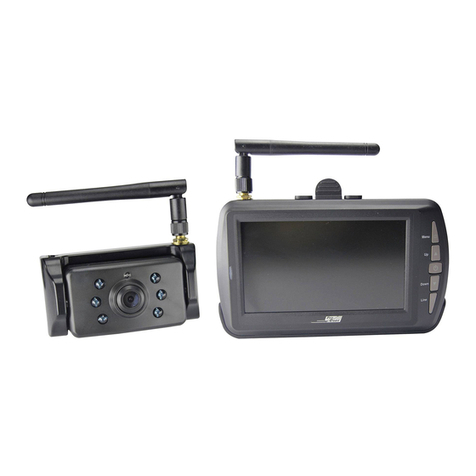
pro user
pro user DRC4340 User manual
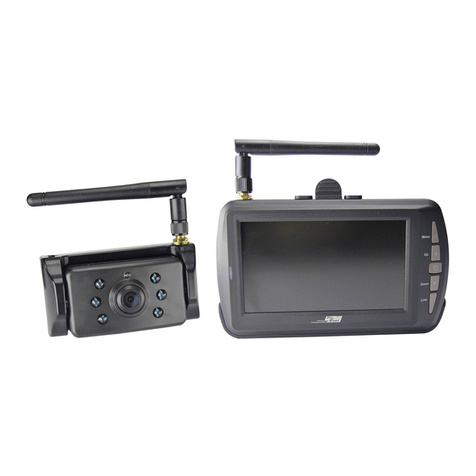
pro user
pro user DRC4340 User manual

pro user
pro user APR043DC User manual
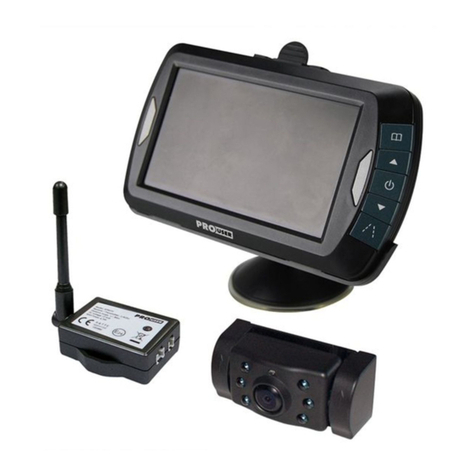
pro user
pro user APR043 User manual

pro user
pro user DRC4340 User manual
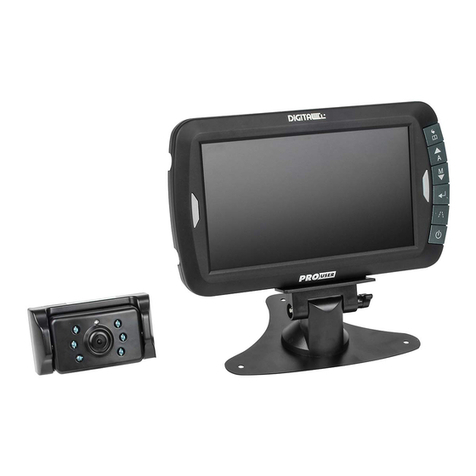
pro user
pro user DRC7010 User manual
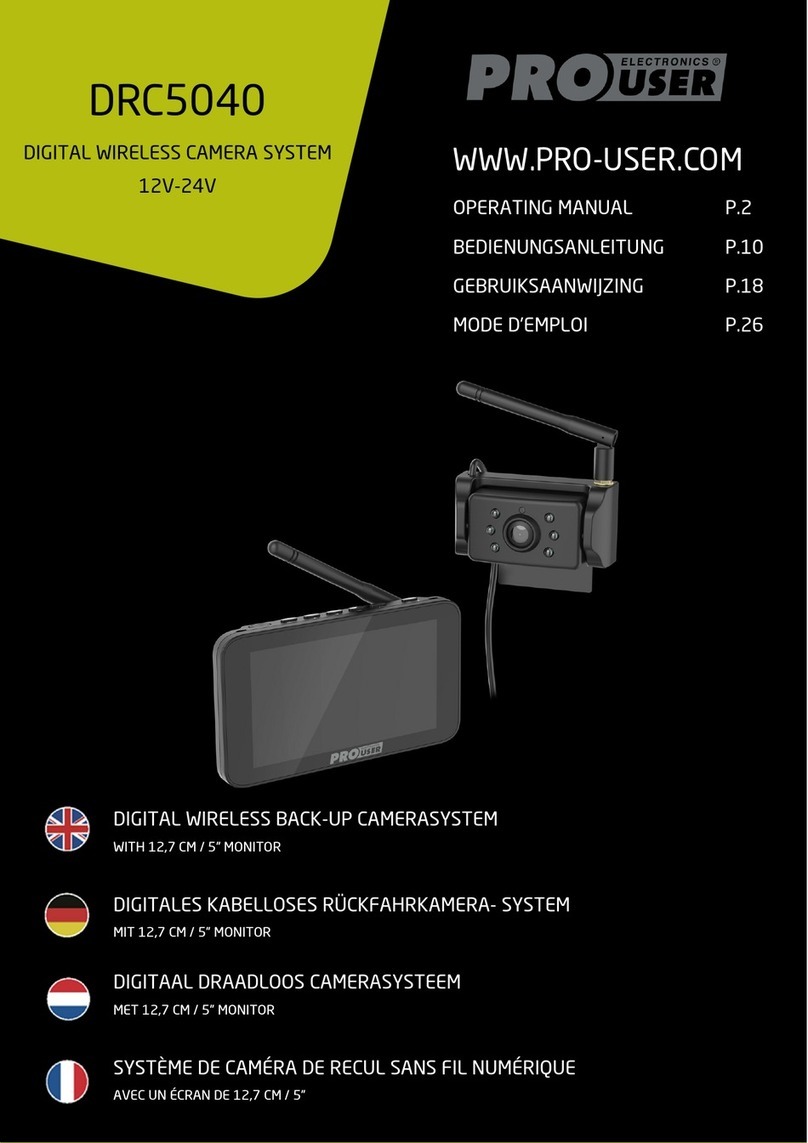
pro user
pro user DRC5040 User manual
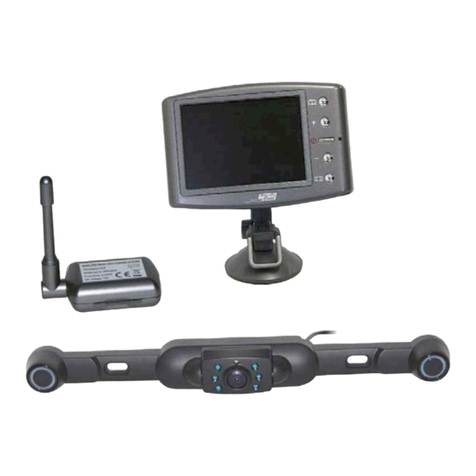
pro user
pro user RPC3600 User manual
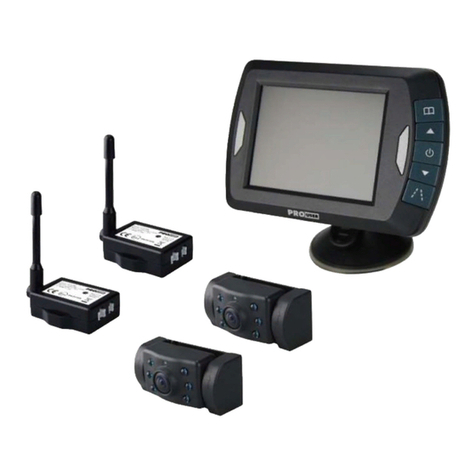
pro user
pro user APR035X2 User manual
